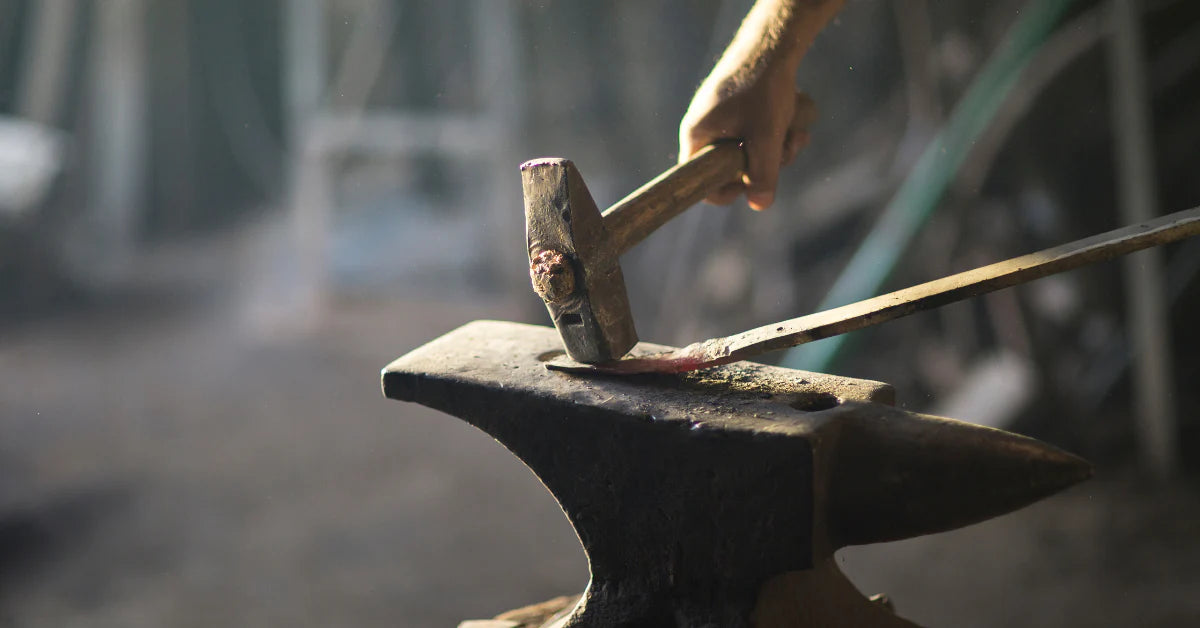
TOOLS OF THE TRADE: A HISTORY OF BLACKSMITHING
ORIGINS AND IRON AGE
Written by Lew Amicone
Blacksmithing began millennia ago, whenthe Hittites began to forge and temper iron around 1500 B.C. It was crude, as all they had were basic tools and fire, but it sufficed for creating weapons such as spearheads and arrows. They were hampered by their scientific understanding of the properties of iron, however.
The metal tools at this point were very simple and not strong at all. They would either not hold an edge very well at all or break easily. However, the alternatives were far worse, so these were still a major advancement, especially in weaponry. To maximize the use of the iron that they had, people would make spearheads and arrowheads that would attach to wooden poles or sticks to create many weapons.
- History of Forging Techniques: From fire to modernity, you can read about ancient forges here.
- Africa’s Iron Origins: Archeological Evidence: Ancient blacksmithing was incredibly common in Africa and the Middle East.
ANCIENT BLACKSMITHING
Charcoal use was one of the greatest advances in blacksmithing in ancient times. It burned hot and for long periods of time, allowing smiths to control the process more accurately and create more complex items. However, their scientific understanding was still very low, so much of the iron work of this time was either soft or brittle. On occasion, they would make steel, which is created by combining iron ore and carbon, which is found in charcoal. These weapons were incredibly powerful for the time and were seen almost as “magic.”
- Ancient Iron Working Processes: Techniques of the past are often reflected in ones used today.
- Iron Smelting Before the Iron Age: Iron smelting was big during the Iron Age, but even before then, some had mastered the craft.
- How the Iron Age Changed the World: Blacksmiths were at the heart of this revolution.
MEDIEVAL PERIOD
Blacksmiths were central to medieval times, often setting up shop in a place of importance in the center of the village. They would make not just weapons but nails, furniture, locks, horseshoes, and armor. The blacksmith became essential to any town, and their techniques improved accordingly. However, the techniques became so advanced and arcane to outsiders that they were also sometimes seen as witches using forbidden magic to make strong weapons. Some blacksmiths were even burned at the stake.
- What Was the Role of the Blacksmith in Medieval Society? Read about the importance of a blacksmith to society during this era.
- Medieval Blacksmith Daily Life: Blacksmiths didn’t spend all of their time making swords.
- Making a Medieval Nail: Learn the process through which a medieval blacksmith might make one of the most common products.
INDUSTRIAL ERA
Blacksmithing began to decline in the Industrial Era as the rise of automation made the personal touch of a smith less necessary. For most basic items, such as weapons and armor, a machine could create countless identical copies of one design, which was cheaper than paying a few people to make the same thing over and over. The only work that wasn’t shifted to machines was farrier work, as that required personal attention to the needs of each horse. Many blacksmiths changed professions during this time.
- Horseshoers, Farriers, and Blacksmiths: What’s the Difference? Learn about the various titles associated with types of smithing.
- Role of the Town Blacksmith: Discover how a blacksmith contributed in many ways to their community.
20TH CENTURY
As with many industries, the demand for blacksmiths ebbed and flowed as the decades went by. Once the Industrial Revolution created factory-made mass-produced ironwork, blacksmiths had to shift to making custom, intricate wrought-iron creations. These products were in great demand during the early 20th century, until the Great Depression. Then, people no longer had the money to spend on the skills of a blacksmith, and demand began to ebb as the craft began to be seen as obsolete.
- Blacksmiths and Smithies in Bygone Times: This is a look into how smithing used to be.
- 20th Century Blacksmith: A modern worker using 20th century techniques explains his life and work.
Modern Resurgence
Starting around 1970, the tide began to shift again for this ancient art. Society began to regain respect for work done with a personal touch, and more people had the resources to support industries built around this level of craftsmanship. Blacksmiths were no longer seen as workhorses creating necessary items for survival through manual labor. Instead, they are now seen as artists, creating works in iron and other metals with both traditional and modern techniques. While the blacksmith may never become the central point of a modern city, their skills are respected, and becoming a blacksmith has once again become a career option for young people.
- Blacksmiths: Forging Ahead in Modernity: Learn about the ways that blacksmiths are active today.
- Keep CraftAlive: Blacksmithing in the 21st Century: An interview with a modern craftswoman focuses on the personal craft of metalworking.
MISCELLANEOUS BLACKSMITH RESOURCES
- Basics of Forging: Learn all you need to get started with smithing in this guide.
- Blacksmithing Basics: Oldfield Forge offers this succinct, straightforward guide to the basics.
- How to Forge a Sword: If you’re interested in weaponry, this step-by-step guide can help you create your very own sword.
- The Blacksmith’s Fire: Fire is one of the most important parts of the process for a smith to control. Learn all of the tricks here.

Leave a comment